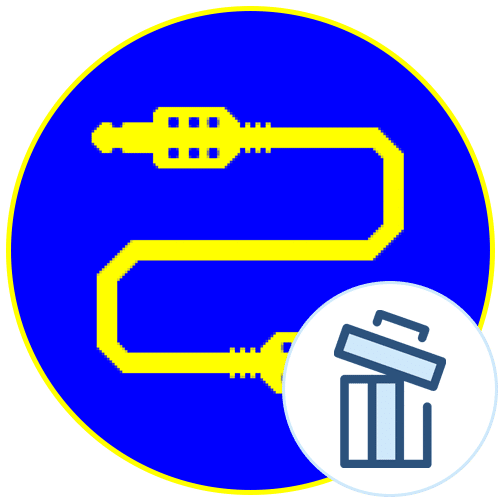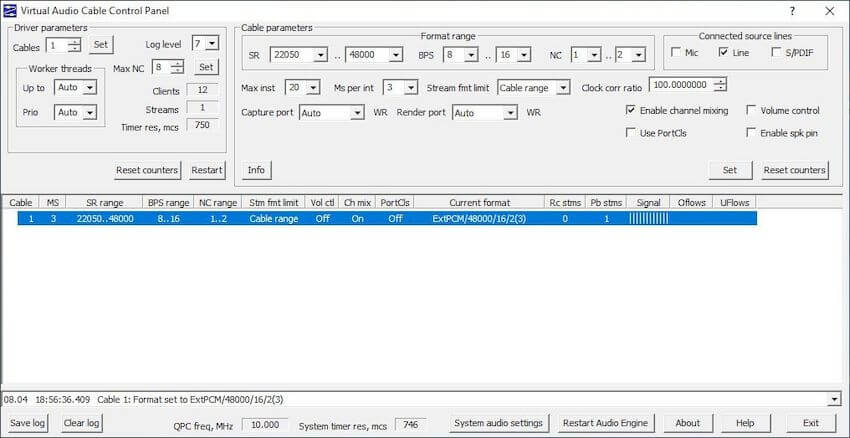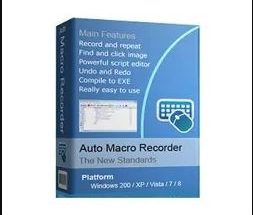Virtual Audio Cable Activation bypass With License Key Full Version Free Download

Unlock seamless audio transmission between applications and devices with Virtual Audio Cable 11.20 Activation Bypass. This virtual audio application facilitates the creation of virtual cables, enabling the transfer of audio streams with pristine quality. Each cable comprises waveform input and output devices, allowing any application to send audio streams effortlessly. With digital transmissions and Bitperinf streaming, there’s no compromise on audio fidelity. Say goodbye to restrictions and experience uninterrupted audio routing for a wide range of purposes, from professional audio production to enhancing your gaming or streaming setup. Elevate your audio experience with Virtual Audio Cable Activation Bypass today.
Virtual Audio Cable Full Version is an audio driver that works with Windows as a virtual audio cable. Thanks to its multi-format audio tools, VB-CABLE can be used without configuration! Ready to work with any MME, KS, DX, KS or WASAPI audio application interface. With VB-CABLE technology, the VB-Audio application can be exposed via virtual I/O and ensures an excellent audio experience. So let’s get started and try the different products we present on this page!
VAC is suitable for recording the audio output of a real-time application (audio player, instant messaging or synthesis software) or for transmitting an audio stream to another application that processes it. For example, you can use two or more streaming/sound/synthesizer/audio programs to create audio streams, send them to the device’s virtual cable, and record a mixed stream over the same device’s virtual cable and delete it with any recording software: Windows. Audio Recorder, Audacity, Sound Forge, WaveLab, Adobe Audition (formerly Cool Edit Pro), Gold Wave, Cakewalk/Sonar, Cubase/Nuendo, v. v…
The Virtual Audio Cable License Key is a powerful multimedia controller (virtual audio devices with input and output ports) designed to connect one or more audio applications and transfer audio streams between them. The software is also available in two versions, free or paid. The free version does not offer full access to key features. Free download of the Virtual Audio Cable (VAC), which allows multiple applications to open the port simultaneously, all audio coming to the playback port is mixed and all clients connected to the capture port can record a single copy of a signal or capture a stream Mixing and distribution are based on a single cable, different cables are completely independent of each other and much more.
To connect one or more audio applications and send audio streams, a powerful multimedia driver called Virtual Audio Cable Activation bypass is used. This virtual audio device has input and output ports. A “virtual sound cable” is a sound card with inputs and outputs connected; No additional audio content required.
By using a free virtual audio cable, you can send audio to additional devices or software. With this software, audio can be easily transmitted without digital cables. There really is no such thing as a virtual audio cable. The software also has a beautiful user interface and is extremely easy to use. This software is compatible with all versions of Windows. The software is available in two versions, both without restrictions. The free edition does not offer full access to important features. Only the premium edition of this software allows you to use all the features. Therefore, there is no reason to worry about a free version instead of a paid version.
A Virtual Audio Cable (VAC) is an audio bridge between applications that sends sounds (audio streams) from app to app, device to device. VAC creates a series of virtual audio devices. Simulate every audio adapter device (card) whose output is connected inside the input, creating a loopback. When an audio application plays on the output, the sound cannot be heard because the signal is looped back to the input. However, when another application records the input, it receives the sound produced by the first app.
Such virtual devices are called virtual cables. The term “Virtual Cable” is used only as a placeholder in the description of the VAC. The actual device/endpoint names you see in the application windows are different (eg “Line 1”, “Line 2”, etc.). Multiple apps can use each side of the virtual cable simultaneously. Sounds directed to the same playback endpoint are mixed. From the recording endpoint, each app gets its own copy of the audio.
Virtual Audio Cable Activation bypass delivers audio signals entirely within the computer. No audio hardware required. No quality loss (as long as there is no format conversion and/or volume adjustment). If all the necessary conditions are met, the audio transmission is quite perfect and suitable for audiophile applications. In well-tuned systems, signal latency is very low.
To transmit/route audio signals from one endpoint (device) to another, VAC provides an Audio Repeater application. Virtual Audio Cable is a tool that allows you to create a set of virtual audio playback or recording devices so that you can use them in any other program without causing the slightest loss of sound quality.
You can connect any external device to your computer, be it a stereo or a musical instrument, and create a virtual device on your computer. You can attach this virtual device to any program you want. This allows you, for example, to record everything coming out of your speakers without losing sound quality (a very common problem).
The configuration options allow you to change more than a dozen different variables to achieve the best possible audio output. However, sometimes a few minutes of trial and error is necessary. Virtual Audio Cable is a handy tool for any user who wants to record sound on their computer. In fact, the program creates up to 256 virtual cables that you can associate with any application or program.
Virtual Audio Cable Free Download connects audio applications together in real time. It’s like a sound card with hard inputs and outputs: when an application sends an audio stream over a virtual cable, other applications can record that stream from the other end of the cable. It allows you to record and process the output of almost any audio application from almost any other audio application.
Audio Repeater is primarily designed for Virtual Audio Cable (VAAC) products, but can also be used independently of VAC for free. This is an application created by Eugene-Muzycken. It allows you to convert any audio input to another audio input through an interface, such as: Ex. Skype, applet, phone, microphone etc. This can be done by connecting the VAC device to a PC or laptop via the USB port and then via the host computer to output sound from your device. The application is free and has no restrictions; However, the application may not handle some common audio formats.
Audio Repeater offers a high quality audio input/output solution. It has been tested on both Windows and Mac operating systems. The website has a free trial version and the full version available for purchase. It works well on all Windows platforms. It has a simple user interface so you can use it easily even without any technical knowledge. Like all other VAC-based programs, it is capable of routing audio via VGA and HDMI.
Virtual Audio Cable License Key can be useful for those interested in video conferencing, video conferencing and simultaneous recording applications. It is also a good choice for audio and video editing. This software comes with Windows Vista, Mac OS X, Linux and others. You can test it by downloading and trying the free trial version. If you like it, you can buy the full version of this virtual audio cable program.
Features & Highlights:
- Local (dashboard) only (does not work through Remote Desktop Services or Terminal).
- The Windows 5.x, 6.x, and 10.x platform (32-bit and 64-bit).
- Maximum 256 virtual device cables (some systems limit the number of MME devices).
- From 1.20 milliseconds per interrupt/event.
- .100 batteries.
- Configure the cables and screen position.
- Distribute the audio channels in software to save them.
- Audio connection software that allows you to connect multiple audio channels online.
- You can see an unlimited number of clients connected to each slot.
- They have the PCM file format with audio samples every second.
- Convert audio information from one format to another live.
- A virtual sound card effect can be created.
- They have handy software that makes the setup process very easy.
- It can access multiple software at the same time.
- It also offers direct spreading and collection performance.
- Improved signal speed on the round line
- Almost any fixed-point PCM audio format (1,000 to 384,000 samples per second, 8 to 32 bits per sample, 1 to 8 channels). Comma format is not supported.
- Almost no audio latency at frequency transition/maximum deviation.
- RTAudio supports event notifications, clock and location log. The write clock is associated with the virtual cable with all flows on all associated cables.
- An unlimited number of kernel streaming clients are connected to each port.
- Mix signal (with saturation) between client output port.
- Convert PCM format (sampling rate, bits per sample, channel number).
- Volume control functions (reduce and increase).
- Channel distribution/collection method.
- A watermark control method to improve flow stability in unstable applications.
- Stream buffering technique to partially compensate for poor application buffering algorithms.
- Control panel application for configuring cables and viewing their status.
- An audio repeater app that streams from any recording to any playback device.
Ease of use
Use VAC in the following audio applications and application classes:
- Telephony via Internet/VoIP/SIP/Voice Messenger (Skype, Discord, Ventrilo, MicroSIP).
- Live mixing/DJ (vMix, Mixxx, VirtualDJ, Banana/Potato VoiceMeeter).
- Live broadcast (Open Broadcaster/OBS Studio, WireCast, VidBlasterX. US Broadcaster).
- Speech synthesis/recognition (Google Text-to-Speech/Speech to Text, Dragon Naturally Speaking).
- Software synthesizers and studios/DAWs (Ableton, Acid, AudioMulch, Band-in-a-Box, Bidule, Cakewalk/Sonar, Cubase, FL Studio, GarageBand, Logic, MiniMoog, n-Track, Nuendo, Reaktor, REAPER, Reason , Samplitude, Traktor, Vegas).
- Audio editors/recorders (Audacity, Adobe Audition, GoldWave, WaveLab, Sound Forge).
- Virtual machines (VMware Player/Workstation, VirtualBox, Hyper-V).
- Amateur and software-defined radios (Flex Radio, PowerSDR, HAM Radio Deluxe, HamSphere, HDSDR, Fldigi, SDR Radio, WSJT-X, JTDX).
- Audio application development – view the application’s audio operations, check the audio being played, provide specific data for recording, etc.
Compatibility
- VAC works on Windows XP, Vista, 7, 8, 8.1 and 10.
No compulsive activities
- VAC just does what it’s supposed to do: forward audio streams between applications, convert audio formats as needed. It will never take you to advertising pages, appear busy on your screen or install hidden activities on your system. VAC only performs the actions that you specifically request.

What’s New?
- Added ARM64 binaries.
- Fixed a driver bug that resulted in faster rendering of streams when using the volume control and/or format conversion.
- Fixed a driver bug that caused the OF/UF values in the current shutdown event to always be zero.
- A client clock adjustment feature has been added to the driver, allowing applications to adjust the wire clock quickly without permanently changing the wire clock correction value.
- Packet mode support is disabled by default to improve transmission reliability in common applications. Added packet mode controls to the VAC control panel.
- Added a workaround for a Windows bug that required high-level clients to start before KS clients.
- The name of the process that created the flow is added to the flow information.
- The algorithm for calculating the actual sample rate has been modified to better reflect recent changes.
- Dynamic cable sync adjustment has been added to audio repeater applications.
- The window layout of KS Audio Repeater has been changed to accommodate low height screens.
- The MME audio repeater now searches for the endpoint by name when starting a transmission. This will avoid restarting the application when the order of endpoints changes (when audio devices are connected/disconnected, when the default endpoint is changed, etc.).
- Added a workaround to the Settings app to remove instances of the hidden “Phantom” device if the previous installation was forcibly terminated.
- The Settings app will now search for uninstallers from previous versions.
- The VAC version increased the driver API to 6.
Virtual Audio Cable License Key:
- AWE4R56T7WY8U9EIDOFIUCY7T6XR5SFATGYHUD
- DSWAE4R5T67Y8U9IOEDIFUYT6CR5DRSFTGYEHFF
- DSER5T67Y8UE9IOFIJUHYTC6R5E4SDRFTEY7FUVD
- DSWAER5T6Y78UEIFUVYT6CR5XESDRFTEY7UFGDF
You May Also Like:
System Requirements:
- System: Windows 7 / Vista / 7/8/10
- RAM: Minimum 512 MB.
- HHD space: 100 MB or more.
- Processor:2 MHz or faster.
How to Install Virtual Audio Cable Activation bypass?
- Download the software and run the installation file.
- Click “I Agree” to continue.
- Select the installation method and click “Next”.
- Change the installation folder and click “Next”.
- Select the components and click Install to start the installation.
- After setup is complete, click Close.
- Done! Enjoy it.
#Virtual #Audio #Cable #Activation bypass #License #Key #Download



